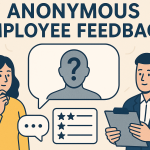In today’s dynamic work environment, the collection of anonymous employee feedback is an essential practice for organizations aiming to enhance internal culture and improve operational efficiency. By offering a platform for candid expression, businesses can gain invaluable insights into the experiences and concerns of their workforce. However, effectively and ethically gathering such feedback requires careful consideration.
While the benefits of anonymous feedback, such as fostering a culture of trust and openness, are well-documented, organizations must navigate potential pitfalls. Missteps can lead to mistrust and reduced participation, ultimately undermining feedback objectives. Therefore, understanding the key do’s and don’ts of collecting feedback is crucial for any organization committed to genuinely engaging with its employees.
This article explores best practices for collecting anonymous feedback, drawing on empirical research and industry experience. From crafting the right questions to ensuring anonymity, we provide a comprehensive guide empowering organizations to harness the full potential of their employee feedback mechanisms. By adhering to these guidelines, companies can transform feedback into a powerful tool for positive change.
Establishing Clear Objectives for Anonymous Employee Feedback
How can organizations ensure that feedback gathering genuinely reflects employees’ needs and concerns? The key lies in establishing clear objectives for the feedback process. Without a defined purpose, feedback initiatives risk becoming unfocused and ineffective. Setting precise goals enhances the relevance of collected data and aligns the feedback mechanism with broader organizational strategies.
Initiating the feedback process with clarity is crucial. Ambiguous objectives can result in scattered, hard-to-analyze feedback. Organizations should identify specific areas to explore, such as employee satisfaction, leadership effectiveness, or workplace safety. Tailoring feedback questions to these areas can extract meaningful insights that drive positive change. For instance, a company might focus on employee morale during a major transition or assess a new management structure’s effectiveness. Such targeted objectives ensure that feedback is purposeful and actionable.
Moreover, aligning feedback objectives with organizational goals enhances the value of the collected information. This alignment ensures feedback initiatives contribute to strategic decision-making and resource allocation. For example, if a company aims to improve employee retention, the feedback process should focus on identifying turnover influences. This strategic alignment maximizes feedback impact and reinforces its significance within the organization.
Organizations can achieve clarity in objectives by involving employees in the feedback process design. Engaging staff in discussions about areas needing attention fosters ownership and leads to more relevant feedback. Additionally, it signals to employees that their input is valued and considered in development plans, fostering a culture of inclusivity and trust.
In conclusion, establishing clear objectives for anonymous employee feedback is essential for maximizing its effectiveness. By aligning with organizational goals and involving employees, companies can ensure feedback is both relevant and actionable, contributing to a more dynamic and responsive workplace culture.
Best Practices for Collecting Anonymous Employee Feedback
Gathering meaningful insights from employees requires an effective and respectful feedback process. Implementing best practices can significantly enhance feedback quality and impact. This section explores crucial strategies for optimizing anonymous employee feedback collection, focusing on privacy, technology, and engagement.
Ensuring Anonymity and Confidentiality
Preserving employee feedback’s anonymity and confidentiality is paramount. Without these assurances, employees may hesitate to share true thoughts, fearing repercussions. Therefore, robust measures to guarantee anonymity are essential.
One effective strategy is using third-party services specializing in anonymous surveys. These platforms collect and aggregate responses without revealing identities. Additionally, securely storing feedback with restricted access reinforces process trust. According to a study by Harvard Business Review, anonymity encourages more candid and honest responses, leading to actionable insights.
To further assure staff, companies should clearly communicate data usage and protection. This transparency builds trust and encourages participation, as employees understand their contributions’ importance and safety.
Choosing the Right Tools and Platforms
Selecting appropriate feedback collection tools and platforms is critical to initiative success. The right technology simplifies the process, enhances data accuracy, and provides valuable analytics.
Organizations should opt for platforms offering customizable surveys and advanced analytics capabilities. Tools like SurveyMonkey or Google Forms are popular due to user-friendly interfaces and powerful features, allowing question tailoring to meet specific objectives and ensuring relevant, insightful feedback.
Integrating feedback tools with existing communication channels can streamline the process and increase response rates. For instance, incorporating survey links in company newsletters or internal messaging apps makes participation convenient for employees. This integration improves accessibility and ensures feedback collection is a seamless organizational routine part.
Encouraging Honest and Constructive Feedback
Creating an environment where employees feel comfortable providing honest, constructive feedback requires deliberate effort. Encouragement and reassurance play vital roles in motivating genuine engagement.
One approach is regularly communicating positive outcomes from previous feedback initiatives. Highlighting changes or improvements from employee suggestions shows their voices are heard and valued, increasing motivation to participate and provide honest input in future surveys.
Additionally, fostering a feedback culture emphasizing respect and openness can significantly impact response quality. Training managers and leaders to receive and act on feedback constructively encourages employees to share thoughts without fear of negative consequences. As Peter Drucker once said, “The most important thing in communication is hearing what isn’t said.” Organizations cultivating such a culture are likely to benefit from rich, constructive feedback driving meaningful change.
Common Pitfalls and How to Avoid Them
Navigating the complexities of collecting anonymous employee feedback can be challenging. The process is fraught with potential missteps that can derail initiatives if not addressed. Understanding these pitfalls and learning to circumvent them is crucial for organizations leveraging feedback effectively. This section delves into common issues like feedback misinterpretation, ignoring employee input, and overcomplicating the process.
Misinterpretation of Feedback
Accurate feedback interpretation requires nuance and context. Misinterpretations can lead to misguided decisions misaligned with employee intentions. Organizations should adopt strategies ensuring clarity and accuracy in analysis.
One effective approach is employing a diverse stakeholder team in feedback analysis. This team provides varied perspectives, reducing bias or misunderstanding risks. Additionally, data analytics tools offering sentiment analysis help decipher underlying emotions and concerns. According to Forbes, integrating technology in feedback analysis enhances interpretation by providing comprehensive insights.
Furthermore, conducting follow-up sessions or focus groups to discuss survey findings with employees clarifies ambiguous responses. This collaborative approach ensures accurate feedback understanding and reinforces a culture of openness and continuous improvement.
Ignoring Feedback or Failing to Act
One of the most detrimental mistakes is collecting feedback and then disregarding it. Such oversight leads to employee disillusionment and decreased future participation. Demonstrating feedback value and action is essential for maintaining trust and engagement.
Organizations should establish a clear action plan post-feedback collection to avoid this pitfall. This plan outlines specific company steps in response to employee input. Communicating these actions back to employees closes the feedback loop and shows their voices have tangible impacts. As management expert Peter Drucker noted, “The best way to predict the future is to create it,” highlighting proactive engagement with feedback’s importance.
Incorporating regular updates on initiatives stemming from feedback solidifies trust. This transparency ensures employees remain informed and engaged, knowing their contributions drive positive change.
Overcomplicating the Feedback Process
A convoluted feedback process can deter full or honest employee participation. Simplifying the mechanism is essential to maximize response quality and quantity.
Organizations should aim for straightforward and concise survey designs. Avoid overwhelming employees with lengthy questionnaires or complex questions. Instead, focus on specific areas of interest aligning with organizational objectives. Clear, direct language also helps elicit useful responses.
Moreover, offering multiple feedback collection channels, such as online surveys, suggestion boxes, or in-person interviews, accommodates different employee preferences and increases participation rates. According to Gallup, diversifying feedback channels leads to comprehensive data collection and better employee engagement.
By recognizing and addressing these pitfalls, organizations can enhance anonymous employee feedback initiatives’ effectiveness. Implementing strategies to avoid misinterpretation, ensure action on feedback, and simplify the process fosters a more responsive and inclusive workplace culture.
Maximizing the Impact of Anonymous Employee Feedback
In summary, anonymous employee feedback collection is a powerful tool for fostering a dynamic and responsive workplace culture. By establishing clear objectives, organizations ensure feedback initiatives are relevant and aligned with broader strategic goals. Emphasizing anonymity and confidentiality encourages honest participation, while selecting appropriate tools streamlines the process and enhances data analysis.
Fostering a culture valuing honest and constructive feedback leads to actionable insights and drives positive change. Organizations must vigilantly avoid common pitfalls like misinterpretation, neglecting feedback, or overcomplicating the process. Addressing these challenges enables companies to transform employee feedback into a catalyst for improvement and innovation.
Ultimately, a thoughtful approach to collecting anonymous feedback improves employee engagement and satisfaction while strengthening the organization’s adaptability and competitiveness. By following these guidelines, businesses can unlock the full potential of their workforce’s insights and contribute to a more inclusive and effective organizational culture.



